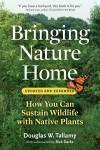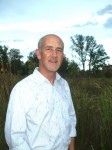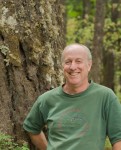
In Broad Ripple, Ruth Ann Ingraham’s landscape is heavily planted with native plants, including the front yard. Photo courtesy Ruth Ann Ingraham
Doug Tallamy is the Pied Piper of native plants. Hear him speak or read his book Bringing Nature Home, and you’ll grab a spade, dig a hole and plant a native plant.
 That’s what happened to Jeff Pitts of Ratio Architects in Indianapolis.
That’s what happened to Jeff Pitts of Ratio Architects in Indianapolis.
“I was already on the road to understanding the native plant thing, but his lecture (in 2009) and book made the connection” between native plants and a healthy eco-system,” said Pitts, a landscape architect.

Jeff Pitts. (C) Jo Ellen Meyers Sharp
He realized that his training was “one dimensional — visual. There was not an ecological component,” said Pitts, a member of the Indiana Native Plant and Wildflower Society, one of the co-sponsors of a return visit for Tallamy at 7:30 p.m., Sept. 13, 2011, at Clowes Memorial Hall on the Butler University campus. Tallamy, professor and chairman of the Department of Entomology and Wildlife Ecology at the University of Delaware, also will speak in Fort Wayne and South Bend, Ind.

Photo courtesy Doug Tallamy
The boring sameness of most residential and commercial landscapes — lawns, evergreens, non-native plants and lots of pesticides — has contributed to a crisis in biodiversity, Tallamy said.
The message hits home.

Photo courtesy Marianne Beal Peters.
“We have developed so much farmland and wild places, robbing our precious native species of habitats,” said Tallamy fan Marianne Beal Peters, a Master Gardener in Plymouth, Ind. “For instance, monarch butterflies depend on milkweed exclusively” in their life cycle. “We don’t realize how much humans depend on that balance, how much the quality of our own lives is improved when we have contact with these creatures,”
People need to think outside the backyard to create neighborhood and community corridors of trees, shrubs and flowering plants that support birds, insects and other wildlife, Tallamy said.
The backyard can be an important link in the chain of biodiversity. “We need to connect these isolated fragments” and working as a neighborhood is one way to do that, he said.
Tallamy challenges local, state and federal highway and roadway departments, too. “There are millions of miles of roadways that could serve as a start to a functioning wildlife corridor.” Roadside plantings of native plants also reduces mowing and other maintenance costs.

Ruth Ann Ingraham amid brown-eyed Susans (Rudbeckia triloba). (C) Jo Ellen Meyers Sharp
The professor’s message is hard to resist, said Ruth Ann Ingraham, a co-founder of INPAWS who frequently writes and speaks about native plants and Tallamy’s book. “He combines the passion, which many of us have, with the science and that’s a winning combination, as far as I’m concerned.”